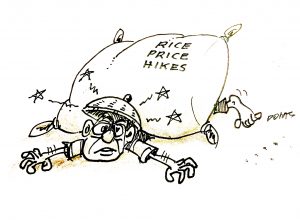As one of the largest consumers of rice worldwide, our country has been experiencing a persistent upward trend in rice prices, which is ironic because we used to be the rice granary of Asia. We can hardly comprehend the intricate factors that contribute to this phenomenon. Why this continuous increase in rice prices? A lot of people just can’t understand.
One of the primary factors behind the rising rice prices in the Philippines is the disparity between supply and demand. The nation heavily relies on rice as a staple food, with domestic consumption exceeding production. Limited arable land for cultivation and insufficient agricultural infrastructure hinder the country’s ability to produce enough rice to meet the soaring demands of its growing population. Additionally, the adverse effects of climate change, manifested through erratic weather patterns, natural disasters, and dwindling water resources, further exacerbate the unstable supply chain. These factors contribute to low domestic production and a consequent dependency on rice imports, driving up prices.
Government policies, particularly those related to importation and trade regulations, significantly impact rice prices in the Philippines. Import duties and tariffs imposed on the importation of rice aimed at safeguarding local farmers can inadvertently lead to higher consumer prices. Furthermore, the government’s move towards tariffication, a process that replaced quantitative restrictions with tariffs on rice imports, has impacted the stability of rice prices. The shift in policy has exposed the industry to global market trends, making the prices susceptible to fluctuations caused by international trade situations and exchange rates.
The ever-increasing prices of rice hurt the Filipino population, particularly the vulnerable segments of society. Rice, being a staple food, accounts for a substantial portion of the household budget. Therefore, when prices surge, it amplifies the burden on low-income families, pushing them further into poverty. Inflation resulting from increased rice prices can also have a cascading effect on other basic commodities, exacerbating the overall cost of living. These implications warrant careful analysis and prompt intervention from policymakers to safeguard the welfare of the population and mitigate the widening socio-economic disparities.
Addressing this problem requires a comprehensive approach, including initiatives to enhance domestic production, improve agricultural infrastructure, and develop sustainable farming practices. Additionally, the government should ensure that trade policies strike a balance between supporting local farmers and maintaining affordable food prices for the general population.




